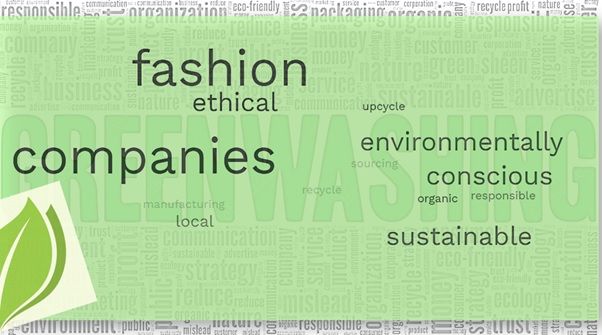Fashion must acknowledge an ingrained reality: It is a polluting, resource-intensive sector, and its future success depends on minimising its impact on the environment and society by adopting sustainable practices throughout the whole garment production cycle. This calls for minimising the effects of growing and manufacturing textile fibres as well as laying a foundation of ethical behaviour at all levels. The battle against ‘McDonaldisation’ in the healthy food industry sector is analogous to the battle for slow fashion.
Making misleading or exaggerated environmental claims about a good or service that are not backed up by genuine eco-friendly practises is known as ‘greenwashing’. To put it another way, it is a type of deceptive advertising that gives the idea that a certain product is ecologically friendly when it is not. So, greenwashing is the practise of deceiving consumers into thinking a product or service is environmentally friendly when, in reality, it may be harmful to the environment or have little impact on it. This practise is becoming more significant as consumers become more concerned about the environment and search for products and brands that are tagged eco-friendly.
Due to rising customer demand for ecologically friendly items, greenwashing has assumed importance. With so many brands vying for customer attention, many businesses try to gain an advantage by making environmental claims. Consumers are sceptical of these claims because many of them are false or only half truthful. Therefore, maintaining credibility and trust with clients has become crucial for organisations.
Companies employ ‘greenwashing’ in a variety of ways, including:

1. Vague or meaningless claims: Some companies make claims that are difficult to verify or refute because they employ phrases like ‘eco-friendly’, ‘green’, or ‘sustainable’, which lack a clear definition or standard.
2. False or incomplete information: In an effort to promote a particular brand’s product or service, some companies may make false or incomplete claims. This can entail drawing attention to a minor eco-friendly aspect without discussing the overall impact of the good or service.
3. Technically accurate language that is irrelevant to the product or service being provided by some brands when referring to the environment. For example, a product could be advertised as ‘CFC-free’ even if CFCs are already prohibited by the law.
However, there are different ways through which people can avoid being fooled by such claims. Searching for third-party certifications like Eco Logo, Energy Star, or Forest Stewardship Council is one of the ways. These certifications show that a good or service has undergone testing and verification by impartial organisations to show it complies with certain environmental requirements. Secondly, to confirm the veracity of the company’s promises, customers can look up the company’s environmental history or read reviews from reliable sources.
Indian fashion companies are starting to understand how important sustainability is becoming to the global fashion sector. These companies are currently making substantial attempts to include sustainability into their business models, from using natural and organic materials to using ethical and environmentally friendly manufacturing techniques.
An important factor in this shift towards sustainability is the rise in customer demand for eco-friendly clothing and growing consumer knowledge of this trend. As consumers’ awareness of sustainable manufacturing and production practises increases, Indian fashion companies are taking action to lessen their negative environmental impact.
Local material sourcing, the use of sustainable and recycled textiles, the reduction of water use, the elimination of waste, and the adoption of eco-friendly production techniques are just a few of the sustainable practises being followed by Indian fashion companies. Additionally, fair labour standards and ensuring that garment workers are treated ethically and paid properly are priorities for Indian fashion companies. This entails delivering programmes for education and skill development as well as safe working conditions and fair pay.
Overall, Indian fashion companies are realising the benefits of sustainability for both the environment and their bottom lines. Customers are becoming more aware of their spending patterns and are looking for brands that are socially and environmentally responsible. Indian fashion businesses can get more clients while also improving the environment and society at large by implementing sustainable practises.
While there are many ethical and environmentally conscious sustainable fashion companies in India, some of them are mentioned here.
1. Bhu: Sattva - This company uses organic cotton, bamboo, and modal to make its apparel eco-friendly. Additionally, it employs natural dyes, and expert artisans’ hand-make the garments.
2. No Nasties - No Nasties is a clothing line that is entirely organic and fair trade. It utilises only natural dyes to create everything from T-shirts to gowns.
3. Doodlage - Doodlage is a sustainable clothing company that makes outfits out of recycled materials which is eco-friendly like organic cotton, linen, and khadi. It combines leftover textiles, industry trash, and worn-out clothing to create its distinctive creations.
4. Bodice - Bodice is an eco-friendly fashion label that collaborates with Indian handloom weavers to produce lovely, long-lasting clothing. It emphasises fair trade principles and employs natural fibres and colours.
5. Pero - Pero is a high-end sustainable fashion label that collaborates with Indian weavers and artisans to produce stunning, classic clothes. It prioritises fair trade principles and works with natural fibres and conventional weaving techniques.
6. Nicobar - Nicobar is a lifestyle company that produces eco-friendly apparel, accessories, and home goods. It prioritises fair trade practises and employs organic and natural materials.
These are just a few of India’s many upcoming sustainable fashion companies. Customers can improve the environment and the lives of the people who create their clothes by patronising such brands. It is because only the end users can balance brands and exert pressure on them to make necessary changes. So, the next time you go shopping for new clothes, focus on their manufacturer and material.








Comments